These 3D Brain Teaser Puzzles Require Logic and Geometry for Exciting Spatial Problem Solving
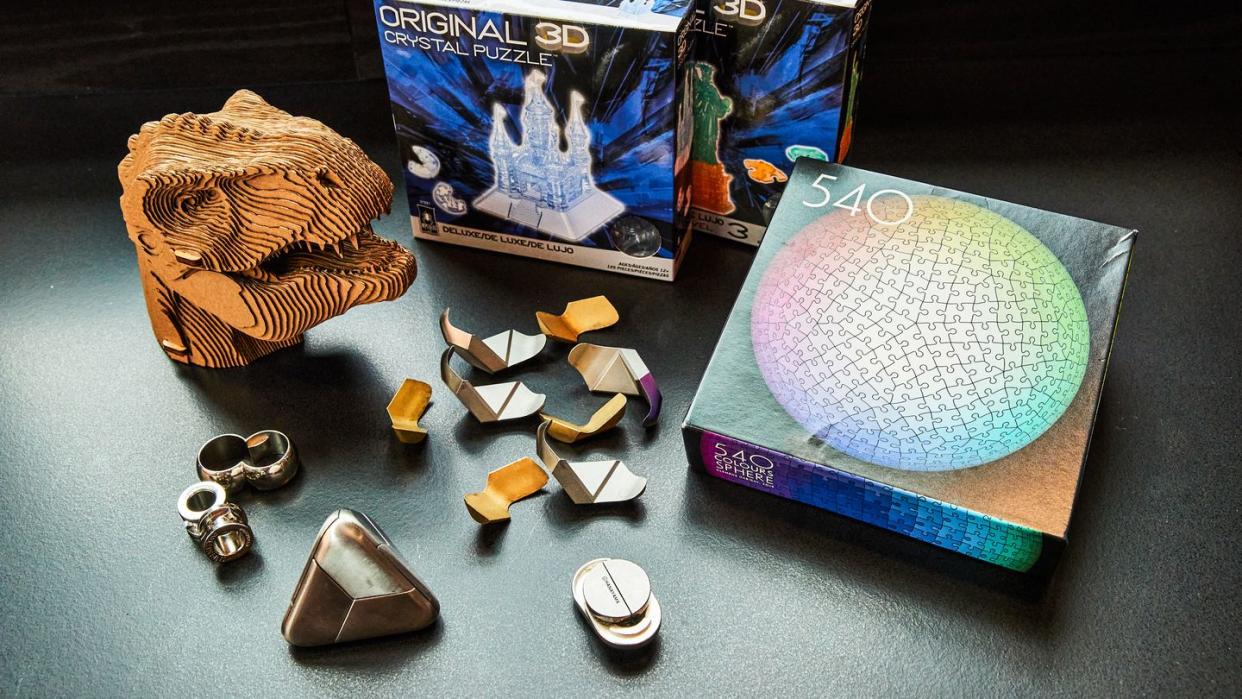
- Oops!Something went wrong.Please try again later.
"Hearst Magazines and Yahoo may earn commission or revenue on some items through these links."
When 2D puzzles are no longer exciting, 3D brain teasers are the way. These handheld puzzles require unlocking several interconnected geometric pieces, inviting logical thinking and spatial problem-solving. While the solitaire-like Kanoodle is currently having a moment through TikTok, several brands offer their own flavor of 3D brain-teaser puzzles—metallic shape-fitting, jigsaw puzzles, or more freeform options that don’t need instructions.
At Popular Mechanics, we’ve got an office full of curious puzzlers and calculated tinkerers. So, to find out which puzzles are worth spending that precious mental energy (and money) on, we called some in, dropped them off in a common space, and Slacked some colleagues to help put them together. If you’re a puzzle fiend and love to get your brain working, below are the ones that most impressed our resident nerds.
Game on and check our picks for the best retro gaming consoles, board games for families, and beginner gaming PCs.
The Best 3D Brain Teaser Puzzles
Best Overall: Educational Insights Kanoodle
Best Upgrade: Craighill Tycho Puzzle
Best Hanayama: Bepuzzled Labyrinth Hanayama
Best for Kids: Uncommon Goods T-Rex 3D Puzzle Building Kit
Best 3D Puzzle: Original 3D Crystal Puzzles Grand Castle Deluxe
What to Consider
Types of Puzzles
Brain teaser puzzles cover a broad range, from multi-piece posers you take apart and reassemble to 3D jigsaws.
Multi-piece puzzles are either lock-based (which involve pulling apart and putting together geometric shapes via turning, clicking, maneuvering, or shimmying each piece) or spatial (which involve organizing and arranging items based on color, shape, or both).
Japanese puzzle maker Hanayama is one of the most popular brands in this space, specializing in handheld cast-iron pieces that require unlocking and removing pieces from one another and putting them back together. Hanayama rates its puzzles using difficulty levels 1 to 6, with higher numbers indicating more difficulty. Of course, these are subjective ratings, but after testing a few, we believe the higher-end Hanayama puzzles involve creative problem-solving that the average person finds difficult.
While traditional 2D jigsaw puzzles are assembled on flat surfaces and resemble a box art image, 3D jigsaws are slightly more challenging. They require spatial awareness—a.k.a., an understanding of how things fit together in space—and actual instructions. Sometimes, the pieces are lettered or numbered. But, like most puzzles, you can kick it into hard mode by tossing those instructions.
Replay Value
Are you someone who enjoys reassembling puzzles? If not, stick to something simple that doubles as a display once it’s complete. Logic puzzles from Hanayama aren’t always the best to show off on a shelf or desktop, but higher-end pieces from Craighill are practically made for showing off. 3D jigsaw puzzles are similar to regular jigsaw puzzles—you likely won’t remember where all the pieces go if you disassemble and reassemble it several months apart.
How We Tested
“Brain teaser” is a bit subjective, but we settled on products that enhance and stimulate spatial reasoning skills, critical thinking, and logic—with a healthy dose of fun. We only focused on puzzles that involve pulling pieces apart and putting them together, playing with colors, and tinkering.
We researched popular puzzle brands and landed on a few major ones: BePuzzled, Hanayama, and Kanoodle-maker Educational Insights. We ignored any products that looked flimsy or cheap. We also avoided any wooden puzzles, as their difficulties are hard to gauge, they’re mostly geared toward children, and, frankly, they remind us of that peg game from Cracker Barrel—also cheap. Lastly, for the sake of brevity, we avoided anything that seemed like a multi-pack overkill, focusing on quality instead of quantity.
BePuzzled, Hanayama, Uncommon Goods, and Educational Insights sent various puzzles for us to try out in our offices. I emptied each box onto a table and told my colleagues, “Hey, come over here and work on these while I watch you tinker.” Through two weeks of work-time breaks, lunch hours, and random communal puzzling sprees, we gauged each puzzle below on effort (How hard is this to figure out? How much time is this taking?), difficulty (How many people did it take to solve?), value (Would we do this puzzle again?), and material (Is it plastic or metal?).
Although we typically keep a 2D puzzle on the table for screen breaks, the puzzlers at Popular Mechanics found that the best 3D puzzles were the straightforward ones that needed little to no explanation. Anything that felt the most enticing to pick up and play, either due to visual attraction or office gossip/word of mouth, topped our final list.
Kanoodle 3D Brain Teaser Puzzle
Kanoodle recently became a TikTok sensation, and after spending hours tinkering with it at the office, picking up games over breakfast, and watching colleagues play it, I can see why: It’s highly addictive. Holistically, it’s got everything I want in a brain teaser puzzle—it’s colorful, pocket-sized, easy to learn, super stimulating, and it makes me feel like a genius when I solve it.
Kanoodle’s goal is simple, but it always proves challenging. The board has 48 spaces, 12 uniquely shaped, color-connected beads, and a booklet of 200 puzzles, sorted in numerical order from easiest to hardest. To play, pick a puzzle from the booklet and set your pieces on the board according to the puzzle’s design. After setup, you’ll notice you have pieces left over. The goal is to fit those pieces on your board without moving the design you just laid out.
It’s comparable to clearing lines in Tetris, except instead of clearing lines, your prize is being able to shut your Kanoodle case. There are also a few pages of 3D puzzles, which involve stacking play pieces on top of each other.
Educational Insights claims Kanoodle expands spatial reasoning skills and enhances critical thinking. Several resources for children with autism recommend Kanoodle for developing fine motor skills, including National Autism Resources and Therapy Shoppe.
“It’s a fun, engaging way to develop problem-solving skills,” says Digital Content Producer Amber Joglar, who spent hours playing this at her desk instead of working (sorry, Amber). “The puzzles get more challenging and involved as you move through levels, and it’s a nice way to get a brain break that doesn’t involve screen time.”
The game is excellent for ages 7 and up, and we especially recommend it for adults looking for a non-screen activity. (It’s helped me calm down on more demanding days.) Its clamshell, pocket-sized packaging makes it easy to travel with and, as evidenced by my office mates, it’s easy to learn and play with others. We simply can’t get enough of this game.
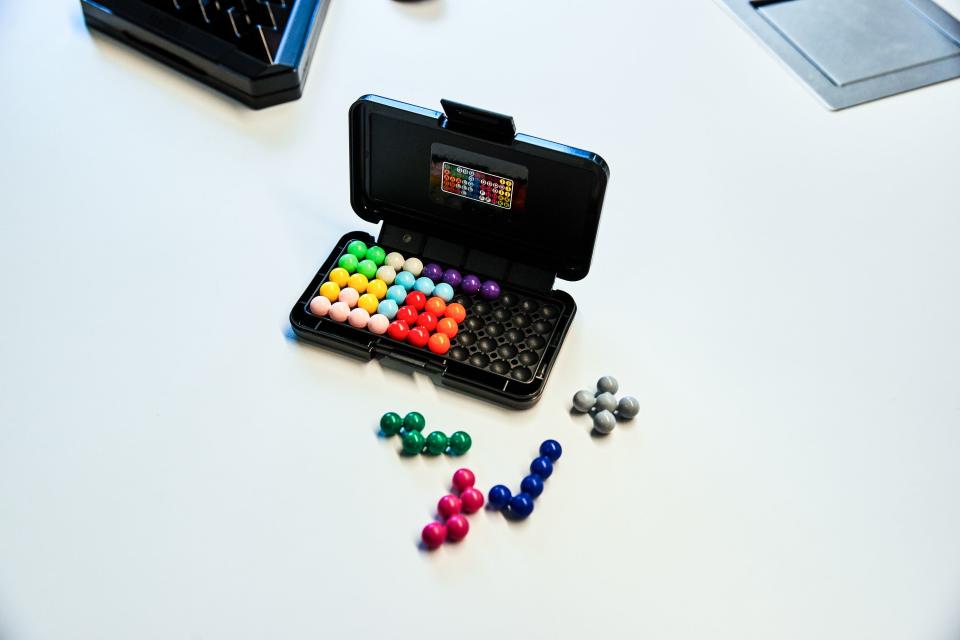
Kanoodle 3D Brain Teaser Puzzle
amazon.com
$9.97
Trevor RaabTycho 3D Brain Teaser Puzzle
The Tycho puzzle is hefty and beautiful, with eight interlocking stainless steel and brass components. You spin it on a countertop to break it apart, then reassemble it by sliding pieces in place. In its core is a hidden cavity that can hold a surprise—large enough for a tiny fortune-cookie-sized message, really—and it’s got a solid weight of nearly 2 pounds. It’s a tough cube puzzle that feels brutalist by design.
We’ve been passing this cube around in the office to see who can assemble it the fastest, and a group of four colleagues got it in less than 30 minutes, though it took lots of tinkering and talking through to reassemble. Many love its weight and feel, and several (myself included) say it looks mesmerizing on a shelf or countertop. It’s definitely a statement piece in a way, maybe establishing authority on a boss’s desk or classiness on a mantle at home.
It also stinks like coins. After toying with the puzzle, the combination of brass and steel had our hands smelling like pennies. If you prefer your puzzles scentless, this may not be for you. It’s also relatively expensive due to its craftsmanship and heavy materials.
We also tried the very similar Tetra puzzle from Craighill, which was as big of a hit in our offices as the Tycho. Though we prefer the Tycho due to its eight-piece makeup (rather than the Tetra’s four), we still enjoyed it. It’s $98—less than the Tycho and still hardy enough to make a statement.
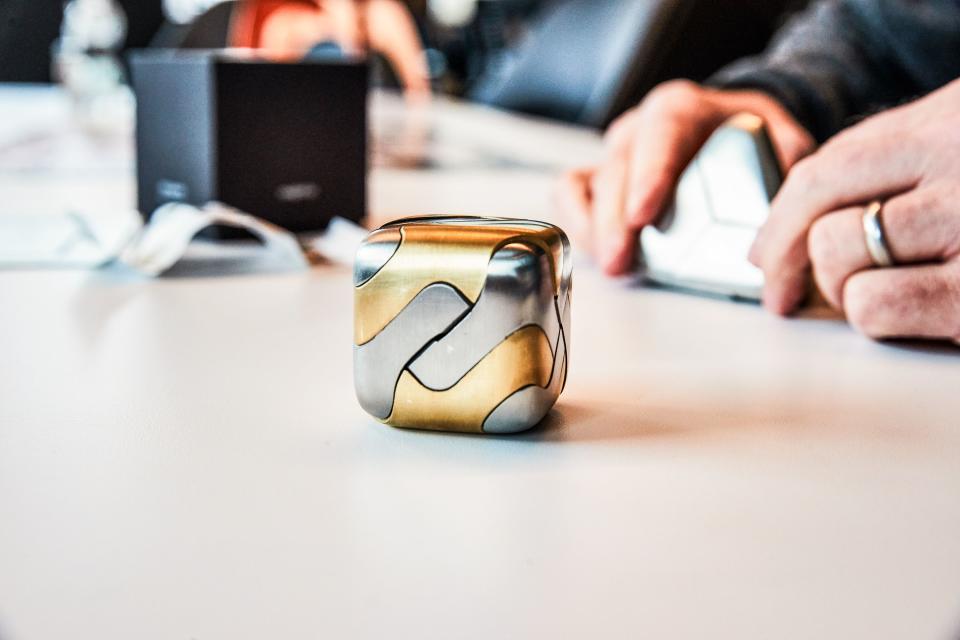
Tycho 3D Brain Teaser Puzzle
craighill.co
$125.00
Trevor RaabHanayama Labyrinth Metal 3D Brain Teaser Puzzle
The objective of this two-piece puzzle is simple: Remove both rings and put them back together. It’s not as easy as it looks. A nub on each end of the horseshoe-like ring marked “Laby” prevents the two rings from pulling away from each other, while both sides of the other ring present two different labyrinths. You must guide the nubs on one ring through the mazes on the other ring, and try not to hit any dead ends on the way.
I tinkered with this Hanayama-branded brainteaser for 20 minutes before giving up. Meanwhile, one of my colleagues fiddled with it for two hours only to get nowhere. Our Assistant Reviews Editor, Adam Schram, successfully pulled both rings apart by feeling his way through the maze while talking and keeping his mind occupied on other things—and in 10 minutes, no less.
The puzzle has a great weight to it. And while it’s made of metal, unlike Craighill’s pieces, it doesn’t stink of it. Both pieces feel like solid cast iron, lending a pleasing tactility and heft. The brand says this puzzle has a difficulty level of 5 for “experts,” but your mileage may vary if you’re anything like Schram.
We also tested the Hanayama Infinity puzzle, in which users pull out bearings from a seemingly invincible figure-8 loop. Staff Photographer Trevor Raab figured it out in less than 10 minutes despite its level 6 difficulty. We do like its design quite a lot, though.
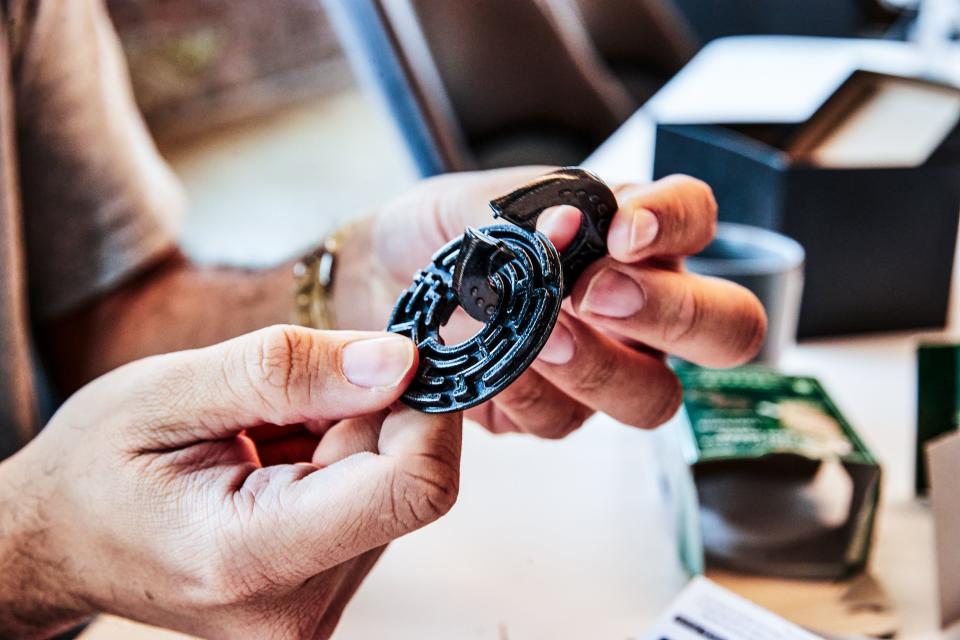
Hanayama Labyrinth Metal 3D Brain Teaser Puzzle
amazon.com
$9.99
Trevor RaabT-Rex 3D Puzzle Building Kit
Not so much a brain teaser as it is a 3D puzzle, this T-Rex 3D puzzle-building kit is still a mild head-scratcher. It takes the traditional 2D puzzle and changes it into a layered pile of 3D cardboard, where you slide pieces into slots to make a shape. It has 72 numbered, precut pieces you pop out of place and attach to each other. The box says it’ll take 60 minutes to complete, but Raab assembled it solo in less than 30.
Because of its easy difficulty level and unique 3D build, we highly recommend this for children learning spatial awareness. It’s also a great art project when complete, as a simple paint job would make this pop in a bedroom or on a desktop. Although it’s made of cardboard, its pieces are sturdy and it doesn’t feel cheap.
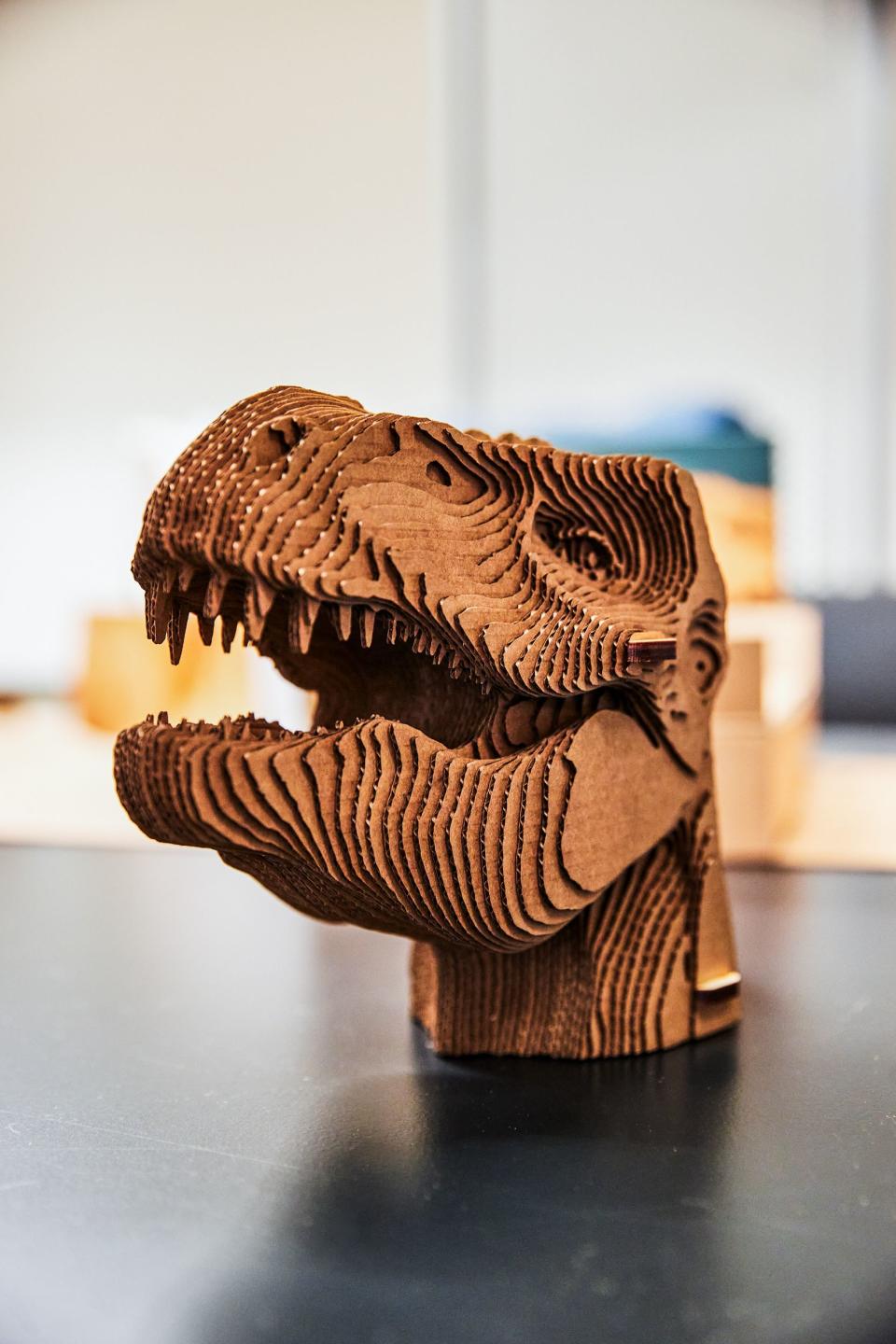
T-Rex 3D Puzzle Building Kit
uncommongoods.com
$40.00
Trevor RaabGrand Castle Deluxe 3D Brain Teaser Puzzle
If this looks annoying to put together, you’ll be happy to know that it very much is. And if you like that sort of challenge, the Grand Castle Deluxe is a frustrating yet satisfying build—the total opposite of the cardboard T-Rex. Rather than slide its parts into place, you assemble this puzzle by correctly stacking and interlocking its 105 transparent plastic pieces. Each piece has tiny (hard to read, due to its clear plastic) letters that correspond to others…somehow. Frankly, we don’t even know if we’re doing it right—it doesn’t come with instructions, and after visiting a URL on the back of the box, its PDF instructions aren’t quite helpful, either.
Its rigor isn’t solely due to a lack of instructions but also its design—every piece looks the same, even if they’re in different shapes. After unboxing and dumping each plastic bag full of pieces out on a table, we had a hard time figuring out where even to start.
It’s not impossible, though. Producer Barry Knoblach took a long while to lay out the pieces and assess the situation. “As someone who prefers finishing puzzles instead of seeing how long they take to complete, I was frustrated when I eventually got stuck,” he says. “The castle’s spires are especially difficult, and no directions came with the box. The puzzle is fun once you get the hang of it, but lack of clarity on its parts knocks my rating of it down.”
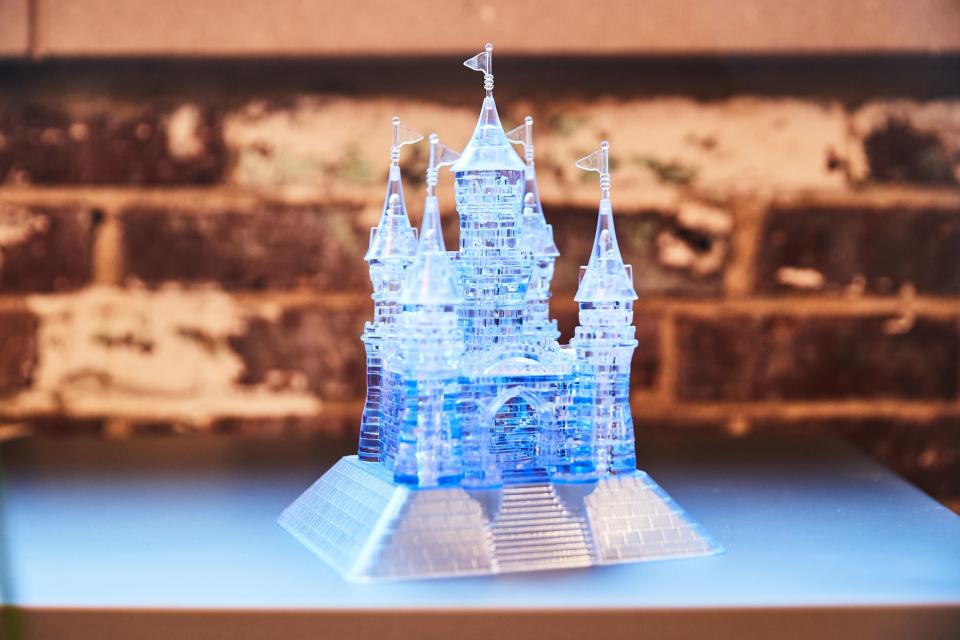
Grand Castle Deluxe 3D Brain Teaser Puzzle
amazon.com
$16.63
Trevor Raab540 Colors 3D Brain Teaser Puzzle
Probably our favorite puzzle to look at and assemble as a group, this sphere is a blast. It has 540 pieces and cycles through a rainbow ombre gradient, transitioning from red to pink to orange to yellow as you spin it. Each plastic piece is slightly curved, and they’re all satisfying to slot together. The finished puzzle sits on top of a plastic pedestal to display.
Four of us assembled this in less than two hours, separating the pieces by color and then attempting to link each bright hue with its washed-out transitional pieces. It’s remarkably sturdy when put into place, and it’s fun to assemble a puzzle in a shape that should, theoretically, be smooth.
The only problem we had with it was its transitional colors. It was difficult to tell which faded, white-washed pieces fit where, as some color differences were hard to make out. The transitions between each colored area isn’t as smooth as we’d like. Piece placement definitely benefits from a second opinion and a flashlight.
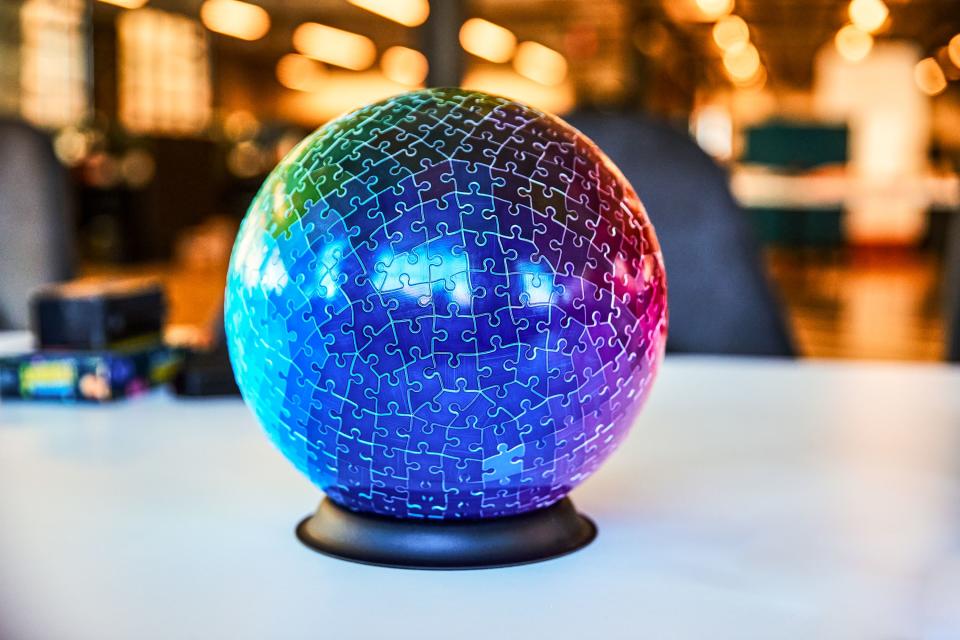
540 Colors 3D Brain Teaser Puzzle
uncommongoods.com
$70.00
Trevor RaabYou Might Also Like

